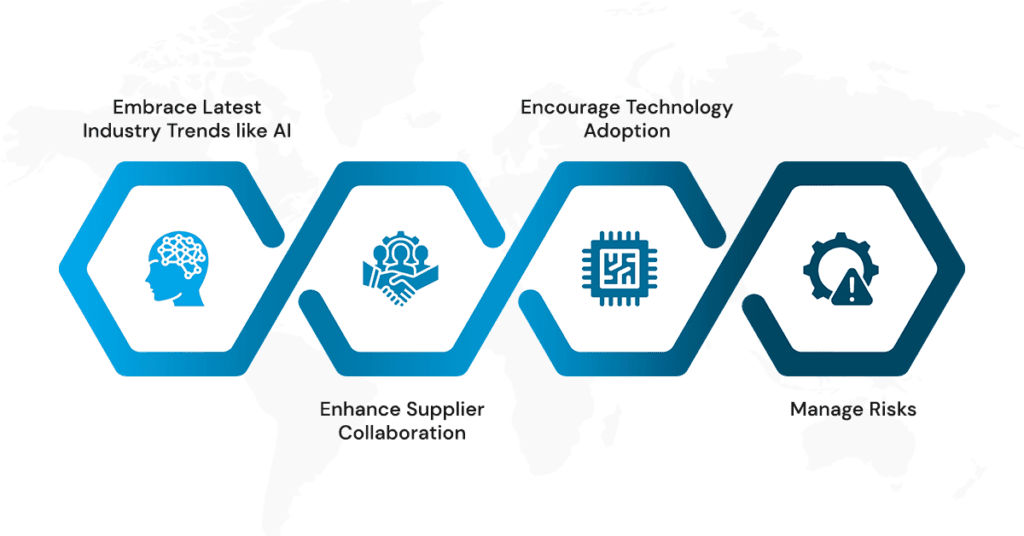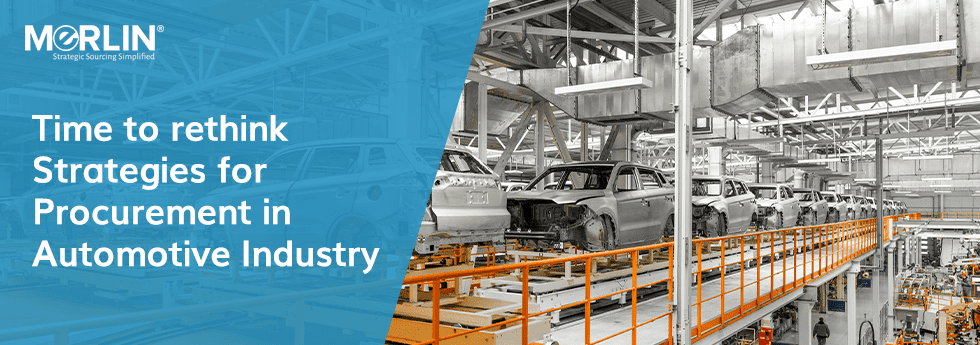The automotive industry is the fourth largest in the world. It is anticipated that by 2030, the global automotive industry revenue would reach about USD 9 trillion. Today, the industry is not just limited to designing a box of metal in a four-wheel configuration with an IC Engine. The focus has shifted to innovative transport solutions – new powertrains using hydrogen, electric and hybrid technology, driverless cars, connected vehicles and sustainability. Thousands of parts are required to make a vehicle and many are not manufactured in-house. Thus procurement in Automotive Industry plays an important role and the industry relies heavily on global supply chains.
The recent supply chain disruptions have hit the automotive industry very hard. The war in Ukraine, Covid-19, US-China trade war, Brexit, US-EU tariff threats, to mention are a few of the recent events that disrupted OEMs as well as their suppliers globally. In this blog, we look at the current state of procurement in the automotive industry, the major challenges and what steps automakers – both auto suppliers and OEMs can take to overcome them.
Table of Contents
ToggleA Glance at the Major Challenges of Procurement in Automotive Industry Today
Globalization and outsourced manufacturing of a majority of autoparts to multiple countries is constantly increasing the complexities and vulnerabilities associated with sourcing and procurement function in the automotive sector. The consequences of recent geopolitical and economic events have added to the numerous challenges the industry has been facing for years:
1. Ukraine Crisis and other similar Geo-Political Challenges

- While 2022 was supposed to be a year of return to normality, the unexpected invasion of Ukraine brought in more uncertainties. Shortage of auto parts manufactured in Ukraine hit European automotive assembly lines quite hard including those of BMW, Volkswagen, etc. The lost demand from Russia and Ukraine accounts for around 1 million units for leading European automakers such as Renault, Skoda, etc. And it is not just confined to Europe.
- Global auto sales have shrunk to 83.3 million from the previous expectation of 86 million units. There are more adverse factors increasing global uncertainty in the global auto market – inflation around the world due to rise in crude oil and raw material prices, fear of recession and so on.
2. COVID-19: Manufacturing halts
- Several countries across the world prohibited transit and imposed nationwide lockdowns, causing supply to lag while various OEMs sites remained temporarily shuttered. Many firms were forced to make large layoffs following massive losses. For instance, Nissan announced the closure of their two manufacturing units in Spain. The consequences were a global decline in automotive supply and demand.
- According to a Study, the production of cars was 91.7 million in 2019, but the pandemic caused a 16% decline in 2020, with just 77.6 million cars produced worldwide.
3. The Semiconductor Crisis

- The present worldwide semiconductor scarcity has taken a heavy toll on the automobile sector. The legacy microcontrollers (MCUs) accounting for about 40% of the global demand are most widely used for manufacturing of automobiles.
- Studies revealed that the global semiconductor supply- demand is rising by 17% per year as compared to a 6% p.a expansion in production between the years 2020 and 2022. This implies that the supply shortage will most certainly endure at least until 2023, maybe beyond as well.
4. Automobile manufacturers betting heavily on electric vehicles and batteries
- Several companies have lately started their pledges towards electric vehicles or the production of zero-emission cars and trucks.
- The increasing popularity of electric cars (EVs) and hybrid models are having far-reaching repercussions for automakers that haven’t formally committed to any EV objective.
5. Liquidity Challenges
- Since last year, the automobile industry’s major concern is liquidity. Manufacturing closures and declining sales progressively resulted in significant monetary losses forcing OEMs to function with minimal liquidity.
Adding on to the above challenges, there are also other perennial challenges the industry has been facing for a long time such as stock and inventory management, logistics management, managing recalls, etc.
What are the best practices to overcome challenges faced in Procurement for Automotive Industry?
The uncertainties and disruptions are certainly putting the automotive sector under pressure. Procurement function will be instrumental in helping the industry pull through. The major goal of automotive procurements to figure out how to acquire the components required at fair price for achieving cost savings while also maintaining the quality and commercial performance of their products.
Here is a list of some of the key strategies procurement organizations in the industry need to adopt to overcome the problems confronting the automobile industry now.
1. From Global to Local
Automotive supply chains mostly have a complex network of interconnected supply bases scattered across the world enticed by lower manufacturing and labour costs. However, as the pandemic resulted in the disruptions of the global supply chains, automotive industries have begun to prioritize local manufacturing and supply chain networks above global ones. Many businesses are increasingly embracing this supplier diversity approach to mitigate the risks of supply chain breakdowns.
2. Modifying the Just-In-Time (JIT) model
In simple terms, JIT is an inventory management model in which the products are acquired from the suppliers only when they are required. The primary goal here is to minimize the holding costs of inventories thereby raising the inventory turnovers. When confronted with the disruptive events of the pandemic, such a model exhibited a considerable lack of resilience. To cope, many automotive companies today are holding considerable buffer stockpiles of parts and assemblies in case of any unfortunate event that can lead to supply chain disruptions.
3. Enhancing Supplier Collaboration and Co-Innovation
Automakers and OEMs should focus on strengthening ties with their suppliers in order to remain competitive. Innovation is no more a company internal initiative but is increasingly driven in collaboration with suppliers. By involving suppliers early on in the product development phase, the automotive industry can rely on collaborative creativity. Suppliers can contribute to innovation in a variety of ways to generate cost reductions and value creation through superior products.
4. Emphasizing on Cost-Efficiency in the Long Run
Today, many automotive industries consider shipping their manufactured automobiles as SKD (Semi-Knocked Down), CKD (Completely Knocked Down), or BUX (Built-up for Exports). Upon receiving, manufacturers in the selected countries are responsible for reassembling them. Such methods, help companies with cost benefits and address deficiencies in R&D capabilities or local production. Procurement teams can work with organizations to identify business cases for such possibilities. However this has to be balanced with increased protections and trade barriers that prevent such imports.
5. Utilizing technology to enhance the process of Procurement in Automotive Industry
A well-planned procurement strategy that is supported by innovative technologies such as AI, data analytics, cloud-based procurement software, business process automation (BPA), and various collaboration tools can aid in enhancing procurement efficiency, optimizing costs to achieve sustainable savings and managing intricate procurement workflows. It helps in identifying risks, bottlenecks as well as potential savings that would otherwise get missed in the mointains of data that the supply chain processes generate on a daily basis.
6. Adopting Risk Mitigation Strategies for the Procurement in Automotive Industry
Calculating risks and incorporating risk mitigation strategies into everyday operations can assist businesses in swiftly shifting from normal to disruptive response mode whenever required. The last two years have taught us that besides a micro view at a supplier level, a broader view of the supply chain also needs to be reviewed regularly for risks.
Conclusion
The automotive industry is among the worst hit by the impact of COVID-19, with vehicle sales plummeting across the world. Now as the things are improving, the automotive sector has begun to show some positive signs and the industry expects growth following the megatrends (connected, electric, autonomous, and mobility). But there’s still a lot to be done to reach the pre-pandemic levels.

In the coming years, sourcing and procurement functions in the automotive sector will need to focus on four key actions to enhance their procurement strategies to allow for faster reorientation in the face of serious disruptions Embrace Latest Technology Trends like AI, Enhance Supplier Collaboration, Encourage Technology Adoption and Manage Risks.
If you want any advice in selecting a procurement solution for automotive industry, do not hesitate to contact us.







